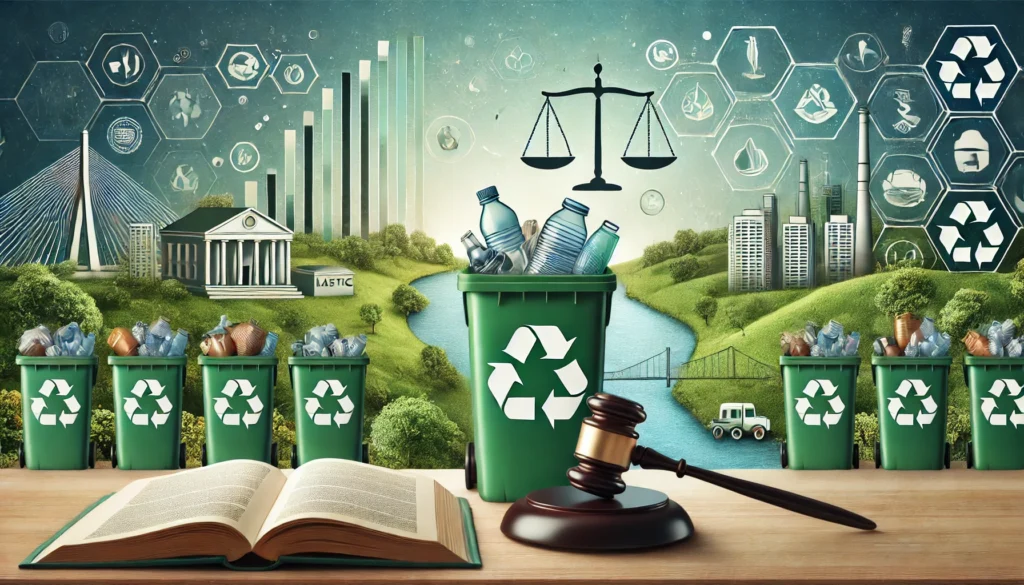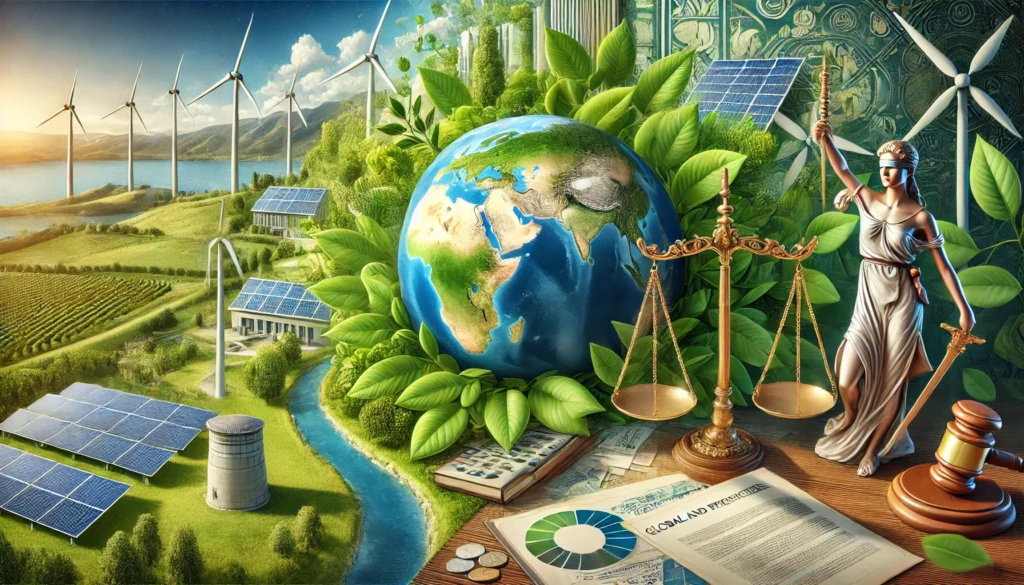Published on 6th February 2025
Authored By: Palwinder Kaur
Abstract
Water pollution is one of the most significant and concerning environmental issues in India which is almost affecting millions of people and natural ecosystems. The need of clean water for every household is the need of the hour. This article provides insight into the legislative framework that is addressing water pollution in India along with landmark cases, and the role of the judiciary. This article also discusses the challenges in implementation of laws while combating water pollution. It also draws lessons from international practices, and offers suitable recommendations for reform. The need for collective and stringent efforts to protect water resources in India is more critical than ever which demands both policy regulation and ground level participation along with a sense of our responsibility and duty to maintain our environment. As per Article 51A(g) (introduced as part of the 42nd Amendment to the Constitution in 1976), which provides for the duty of every citizen of India to protect and improve the natural environment, including forests, lakes, rivers, and wildlife.[1]
According to the “Composite Water Management Index” report published by Niti Aayog in June 2018, India ranks 120 amongst 122 countries on the Water Quality Index, with nearly 70% of water being contaminated.[2]
Introduction
Water is a fundamental resource to sustain life on earth. Without water, life is not possible on the planet. The contamination of water resources poses a serious threat to human life and ecosystems. It affects the health, biodiversity and economic state. With the growth of industrialization and urbanization in India, water pollution is at alarming levels. Holy rivers like Ganga and Yamuna, are examples of severe water pollution caused by factories and urbanization etc. Pollutants varied from industrial waste and agricultural pesticides to untreated sewage and plastic waste degraded the water resources like lakes, rivers and even oceans. Over the past years, increasing water pollution with decrease in per capita water availability creates a serious issue for future availability of water. Besides implementing several water regulation measures and schemes in India, water law remains largely sectoral to-date. Water law in India, includes international treaties, federal and state acts. It also includes a number of less formal arrangements, including water and water-related policies as well as customary rules and regulations.[3]
India has developed a legal framework of laws to combat water pollution, such as Water (Prevention and Control of Pollution) Act, 1974. Despite these measures, the implementation of these laws faces numerous challenges. This article explores the evolution of water pollution laws, their effectiveness, and the steps needed to ensure clean water for all.
Historical Evolution of Water Pollution Laws in India
Pre-Independence Context:
India’s economy was primarily rural and there was a little industrial development before independence. Traditional methods were firmly rooted in water conservation, and community-managed systems like tanks, baolis, and step wells. These methods made sure that water supplies were used sustainably while keeping the resources clean. However, because industrial-scale contamination was essentially non-existent at that time, there was no official legal framework to deal with water pollution.
Post-Independence Era:
Rapid urbanisation and industrialisation during the post-independence era caused water contamination. An early legislative foundation for dealing with public nuisances, such as water contamination, was established by the Indian Penal Code of 1860. These provisions, however, were insufficient to address urban waste and large-scale industrial-chemical waste. One of the earliest initiatives to regulate interstate rivers was the River Boards Act of 1956, however it prioritised water distribution over pollution prevention. Although it emphasised the need for central coordination in the management of river systems, it lacked the power to address household and industrial waste.
Although the constitutional framework limits the central government’s ability to regulate water as it was treated as a state subject, the significance of national water management has already been acknowledged in some sectors. Therefore, in 1974, Parliament did pass the Water Act, which addressed water pollution. This act aims to preserve and restore the wholesomeness of water while preventing and controlling pollution. It grants water boards the authority to establish guidelines and rules for pollution prevention and control.[4]
The existing legal framework for water is supplemented by a human rights component. Although the Constitution does not explicitly state a basic right to water, court judgements have interpreted Article 21 (right to life) to imply one.[5] Recognising the right to a clean environment implies the right to water as well. The Supreme Court ruled in Subhash Kumar v. State of Bihar that the right to life includes access to clean water and air.[6] In the Sardar Sarovar case, the Supreme Court inferred the right to water directly from Article 21. The article mentioned that water is essential for survival.[7]
The Water (Prevention and Control of Pollution) Act, 1974
The Water Act of 1974 was a turning point in Indian environmental law and continues to serve as the foundation of the country’s water pollution control policy. The Act was enacted with the primary purpose of preventing and regulating water. It also provides regulation to make sure that water is safe for uses. It introduced a framework for comprehensive water quality control.
The key characteristics and provisions of the Act include:
Pollution Control Boards: The Act designated the Central Pollution Control Board (CPCB) and State Pollution Control Boards (SPCBs) as the principal regulating authorities. These boards are responsible for monitoring water quality, implementing pollution control regulations, and advising the government on policy issues.
Effluent Standards and Industry Compliance: Before releasing industrial effluent into water bodies, industries must have SPCB approval. To guarantee that released water does not endanger aquatic ecosystems or jeopardise human use, strict effluent regulations have been set.
Pollution Prevention Zone Designation: The Act gives authorities the authority to designate particular locations as pollution control zones, where the release of pollutants is subject to stringent regulations.
Inspection and Monitoring Authority: As per the provision of this Act, Pollution Control Boards have the right to examine industrial facilities, gather samples, and examine effluents. The boards have the authority to punish infractions or order the closure of industries.
Public Awareness and Participation: The Act places a strong emphasis on how important public awareness is to reducing water pollution. Public hearings are held in cases involving large-scale projects, and citizens are urged to report infractions.
Establishment of Laboratories: In order to support ongoing research and monitoring, the Act provides for the construction of laboratories and facilities for testing the quality of water.
Penalties for Failure to Comply: The requirements of the Act may be broken by fines, incarceration, or both. The purpose of penalties is to discourage industries from breaking pollution regulations.
Comprehensive Water Quality Monitoring: In accordance with this Act, the CPCB has put in place national programs for water quality monitoring, guaranteeing data-driven decision-making.
Despite the strengths of Water Act, enforcement in implementation remains a challenge due to limited resources. Strengthening these mechanisms is critical to achieving the Act’s objectives.
Environment (Protection) Act, 1986
The Environment (Protection) Act was enacted in the year 1986. It was enacted in the wake of Bhopal Gas tragedy. It’s main objective to provide provisions for the protection and improvement of environment. The Act is one of the most comprehensive legislations with a pretext to protection and improvement of the environment. The Constitution of India also provides for the protection of the environment. Article 48A of the Constitution specifies that the State shall endeavour to protect and improve the environment and to safeguard the forests and wildlife of the country. Article 51 A further provides that every citizen shall protect the environment.[8] It empowered the central government to:
- Set water quality standards and monitor compliance.
- Regulate industrial activities impacting water resources and bodies.
- Establish rules for hazardous waste management and pollution control technologies.
Chapter III of the EPA deals with the prevention, Control and abetment of Environmental Pollution. Some important provisions of this chapter provide that, No person carrying on any industry, operation or process shall discharge or emit or permit to be discharged or emitted any environmental pollutant in excess of such standards as may be prescribed.[9]
Apart from the above-mentioned Acts, there are more legislation governed the water pollution regulations in India includes: Forest Conservation Act 1980; Public Liability Insurance Act 1991; Environment Assessment Development of Projects, 1994; etc.
Landmark Case Laws – Water reforms
Subhash Kumar v State of Bihar (1991): In this Landmark case, the Supreme Court of India, held that “the right to live ‘includes the right of enjoyment of pollution free water and air for full enjoyment of life. This is an important aspect of right to life enshrined under Article 21 of the Constitution and a citizen has right to have recourse to Article 32 of the Constitution for removing the pollution of water or air which may be harmful to the quality of life.” [10]
Vellore Citizens’ Welfare Forum v. Union of India (1996): A writ petition was filed in this case, against the large-scale pollution caused by tanneries and other kinds of industries in the state of Tamil Nadu. It was alleged that untreated effluent was being discharged into agricultural fields, waterways and open land, which ultimately reached the Palar river (main source of water supply to the residents). The effluents from factories had spoiled the physiochemical properties of the agricultural soil and contaminated the groundwater as well. The Apex court awarded the compensation to victims while recognizing the right of the people to a clean and healthy environment, on the basis of the ‘precautionary principle’ and the ‘polluter pays principle’.[11]
M.C. Mehta v. Union of India (1988) This case focused on the pollution of the Ganga River by industries and municipalities. The Supreme Court directed the closure of polluting tanneries and emphasized the necessity of effluent treatment plants to restore water quality. (Source: Supreme Court of India Judgment AIR 1988 SC 1037).[12]
Narmada Bachao Andolan v. Union of India (2000): In this case, the Supreme Court observed that “Water is the basic need for the survival of human beings and is part of the right to life and human rights as enshrined in Article 21 of the Constitution of India….and the right to healthy environment and to sustainable development are fundamental human rights implicit in the right to “life”[13]
Almitra H. Patel v. Union of India (2000) This case addressed untreated sewage contaminating water bodies. The Supreme Court directed municipalities to implement effective waste management systems to reduce water pollution.[14]
Indian Council for Enviro-Legal Action v. Union of India (1996) This landmark case focused on industrial pollution in Rajasthan, where chemical industries caused extensive groundwater contamination. The Supreme Court ordered compensation for affected communities and the cleanup of polluted sites. [15]
The Supreme Court has consistently upheld the right to clean water as a fundamental right under Article 21 of the Constitution through the number of judgements over the decade. The Apex court emphasize that access to clean water is essential for a dignified life and environmental sustainability.
Challenges in Implementing Water Pollution Laws
Enforcement Challenges:
Despite the existence of legal frameworks in India, implementation remains inconsistent. Industries sometimes, surpasses the effluent discharge quality as per the regulation, and penalties are either delayed or insufficient to deter violations.
Institutional Challenges
The overlapping jurisdictions of various regulatory bodies lead to confusion and inefficiencies. For example, the CPCB, SPCBs, and local authorities often lack coordination, resulting in delayed enforcement.
Public Awareness
Public understanding of water pollution laws remains limited. Mostly Rural Communities living near water bodies often lack the knowledge or resources to seek legal remedies, exacerbating the problem.
Urbanization and increasing population:
Rapid urbanization creates an enormous pressure on urban water systems, resulting in untreated sewage, plastic waste, and industrial discharges entering water bodies such as rivers and lakes. With infrastructure struggling to keep pace, the scale of pollution continues to grow.
The Way Forward
To address water pollution effectively, it is essential to strengthen existing laws by updating them regularly to tackle emerging pollutants like pharmaceuticals and microplastics. In the wake of alarming water pollution, stricter penalties for non-compliance to regulations provided by water Act and other legislation must be enforced. The use of technology in improving water quality and waste management should be advanced including – AI-based compliance tracking and regular industrial audits. Public awareness and participation by educating individuals about the fundamental rights and involving them in local water monitoring initiatives can help bridge implementation gaps. The industrial organizations should adopt cleaner technologies to reduce the harmful chemical waste in water. The sense of responsibility among all stakeholder regarding the serious concern of water conservation should be raised by adopting the webinars and seminars programs. To reduce the court’s burden, special courts for environment pollution matter should be setup to dispose of the cases speedily.
Conclusion
Water law in India, is combination of formal and informal laws, rules and guidelines. It has evolved over time as issue of water pollution keeps increasing. Over the past few decades, a more coordinated approach at regulating water law has been put in place. This is meant to make water law suitable to face the hurdles in combating water pollution in the 21st century. Ongoing water law reforms and schemes may contribute to enforce water management but they are conceptually incapable of watching the human right, societal, environmental and other aspects of water. This is quite a concern that none of the water law is based on the constitutional right to clean water and the principle of public trust.
References
[1] Article 51, The Constitution of India, 1950
[2] Composite Water Management Index” report published by Niti Aayog in June 2018 available at https://timesofindia.indiatimes.com/blogs/voices/unlocking-the-vast-potential-of-water-quality-data/
[3] Philippe Cullet, WATER LAW IN INDIA OVERVIEW OF EXISTING FRAMEWORK AND PROPOSED REFORMS https://www.ielrc.org/content/w0701.pdf
[4] Water (Prevention and Control of Pollution) Act, 1974
[5] S. Muralidhar, ‘The Right to Water: An Overview of the Indian Legal Regime
[6] Paragraph 7, Subhash Kumar v. State of Bihar, AIR 1991 SC 420
[7] Narmada Bachao Andolan v. Union of India, Writ Petition (Civil) No. 319 of 1994, Supreme Court of India, Judgment of 18 October 2000, AIR 2000 SC 3751,
[8] The Constitution of India, 1950
[9] Chapter III, The Environment (Protection) Act, 1986
[10] Subhash Kumar v. State of Bihar, AIR 1991 SC 420
[11] Vellore Citizens’ Welfare Forum v. Union of India, AIR 1996 SC 2715.
[12] M.C. Mehta v. Union of India AIR 1988 SC 1037
[13] P. R. Subhash Chandran v Government of Andhra Pradesh & Others (2001)
[14] Almitra H. Patel v. Union of India (2000) AIR 1996 SC 1446
[15] Indian Council for Enviro-Legal Action v. Union of India (1996) AIR 1996 SC 1446




